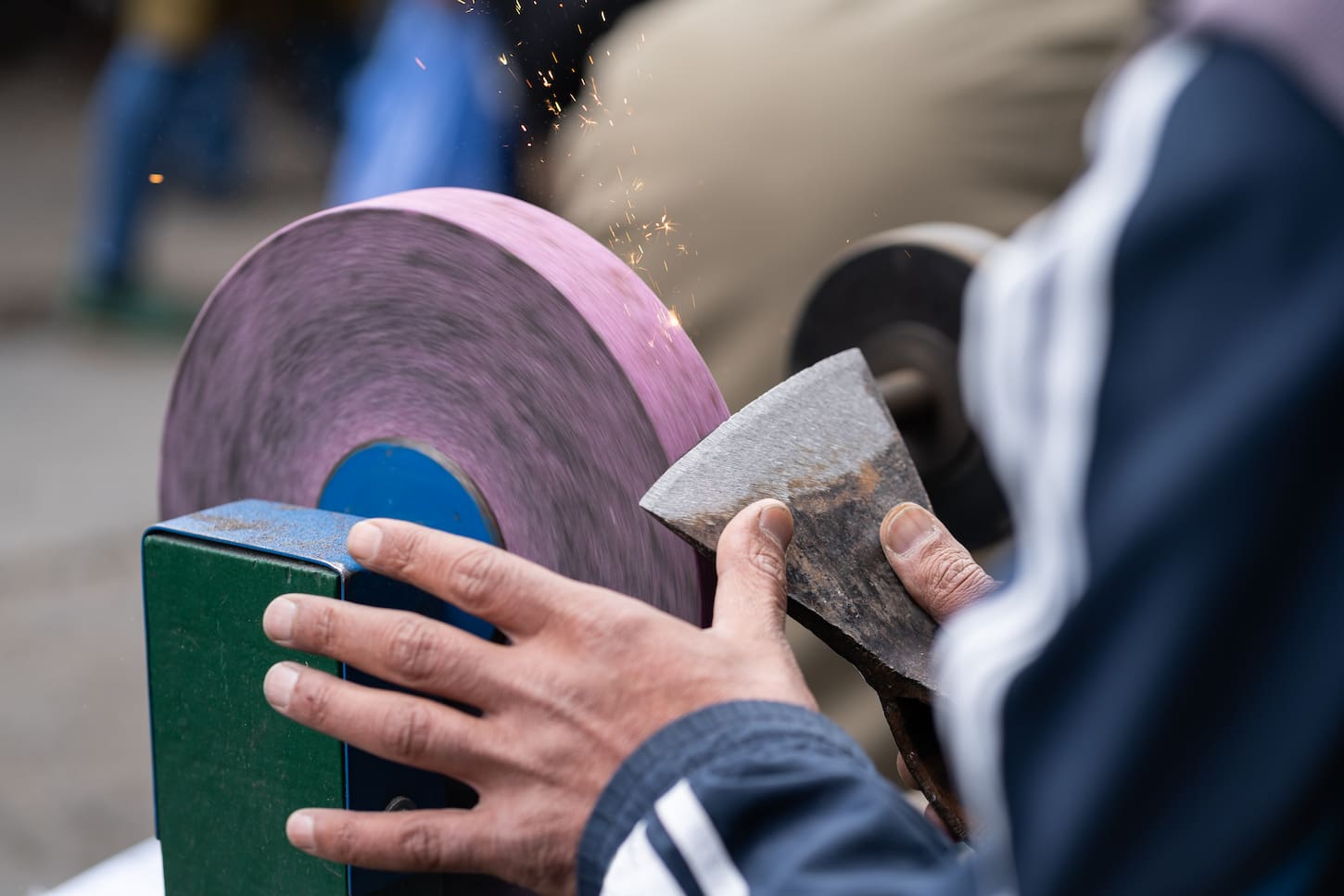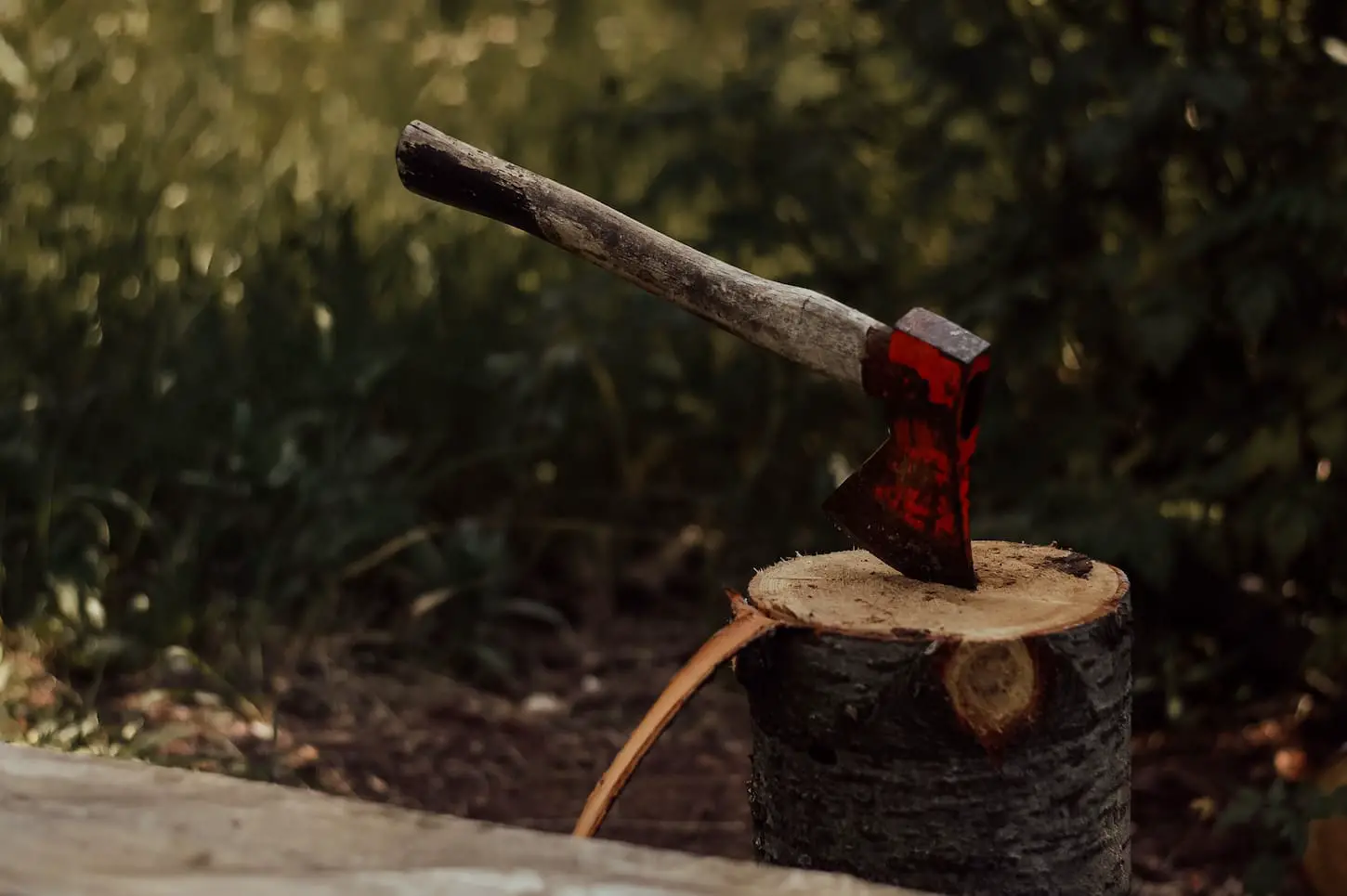An axe is an essential piece of homesteading equipment that many people know how to use, but not many people know how to maintain. As with any edged tool, the cutting edge will not only determine how well the tool works but also how safe the tool is to use. Knowing how to keep your axe sharp is as important as knowing how to use it. So, how do you keep your axe sharp, and can you sharpen an axe with a knife sharpener?
You can sharpen an axe with some knife sharpeners, but others will not be appropriate for the task. Whetstones or sharpening stones are the best knife sharpening tools that can be used on an axe. Most fixed-angle knife sharpeners do not have the correct angle for putting an effective edge on an axe.
An axe is an edged tool, right? So can you use the same principles to sharpen an axe as you can with a knife, which is another edged tool that you may be more familiar with? Even though an axe is an edged tool, there are some differences in the blade design, function, and geometry that you need to know in order to be able to re-establish a robust, sharp edge on your axe.

Can You Use A Knife Sharpener to Sharpen An Axe?
The answer to this question depends on what is meant by a knife sharpener. A knife sharpener means different things to different people, and some knife sharpeners can be used to sharpen an axe, while others will not work at all to put an edge on your axe.
Many people complicate the sharpening of an axe too much. An axe is not a scalpel or a high-end Japanese kitchen knife, which means that it does not need a fine super sharp edge. This is not to say that an axe does not need to be sharp, but it does mean that the axe only needs to be sharp enough to perform its intended purpose.
The biggest problem with sharpening an axe on a knife sharpener is that the angles on the edge of an axe are somewhat different from that on the edge of a knife. Many knife sharpeners don’t cater to the angles required for the axe blade and therefore only have angles that are suitable for knife blade sharpening.
I talk a lot more about angles and ax sharpness in this article: Can an axe be too sharp? (What is too much). That should help you understand some of the geometry of axe sharpening. I’d recommend you open that in a new window and check it out – either after finishing this article or whenever.
Let’s take a look at some knife sharpeners and see how they will fare in the role of sharpening your axe.
Knife Sharpeners You Should Not Use On Your Axe
Most of the knife sharpeners that you should never attempt to use on your axe are the ones that have fixed angle grinding.
Sharpeners that employ this system for sharpening generally only have angles that are suitable for knife blade angles.
An axe edge should be sharpened at an angle of 25 to 30-degrees which is a much wider angle than what most knives are sharpened at and also, therefore, normally not provided for on knife sharpeners with fixed angles.
As a result, the following knife sharpeners should be avoided for using on an axe.
- Electric knife sharpeners.
- Pull-through fixed angle knife sharpeners.
- Knife sharpening systems with angles below 25-degrees.
Trying to use these knife sharpeners on your axe has the potential to not only ruin the edge on your axe but also potentially destroy your knife sharpener.
Knife Sharpeners You Can Use On Your Axe
Fortunately, there are some knife sharpeners that you can use to put an edge back on your axe. This is particularly convenient if the sharpening method is portable for when you are out in the field and need to get a working edge back on the axe.
- Knife sharpening systems that allow an angle adjustment of up to 30-degrees. The system will also need to have sufficient capacity to secure the axe blade in place to perform the sharpening. Knife sharpening systems that cater to up to 30-degrees will generally have sufficient capacity to secure the axe in place.
- Whetstones. Whetstones come in a variety of types and grits, from stones to diamond stones, to ceramic stones. The best whetstones for axe sharpening are the traditional water or oil stones and diamond stones.
- Belt knife sharpeners. These are custom-made tool sharpeners that use abrasive belts to sharpen knives, axes, and various other tools that require a sharp edge. These machines can be quite expensive and are certainly not portable due to their requirement for electricity.
Of these types of knife sharpeners, the whetstones are probably the most suitable for the purpose. Not many knife sharpening systems have the capacity to hold the large, bulky axe head in place while the sharpening is done. The belt systems work well but can be costly and are certainly a less portable solution.
Whetstones offer the most versatility because the process is manual, and the angle can be easily adjusted by simply changing the angle of attack to which you bring the axe edge to the stone.
Generally, with whetstone sharpening of an axe you will need at least two grits of stone as a minimum, with possibly more, depending on how you want to finish the edge.
Many whetstones come with two grits back to back in a single stone which makes them easier to buy. By buying two whetstones, you can potentially get 4 different grits. This is only true of the water or oil stones since the diamond stones usually come in single grit plates.
For a set of whetstones for axe sharpening, we would recommend a repair stone with coarse grits, such as a 120-grit and a 300-grit. You will then need a sharpening stone with a combination of about a 400-grit and a 600-grit stone.
The coarse fixing stones will allow you to quickly remove nicks and chips from the edge of the axe blade. The edge can then be sharpened and refined with the 400 and 600-grit stones. To really finish off the edge nicely, a couple of passes over a leather strop with a light grinding compound on the leather will polish the edge and enhance the sharpness.
This YouTube video is a great resource I used to learn more about sharpening axes properly. It’s worth watching. If you don’t want to know why he’s sharpening it, start at 1:00 on into it.
The Best Way To Sharpen An Axe
The best and simplest way to sharpen an axe only requires one sharpening stone or whetstone grit combination, a metal file, and a leather strop.
With this method, you will only need the combination 400-grit and 600-grit stone for sharpening. The rough work to repair the axe edge is done with a metal file.
Use the file to file the axe bevel to remove the damage to the edge. Don’t file too much on one side at a time, but turn the axe over often and work both sides to keep the sharp edge in the middle of the axe.
Take care to keep the filing to the current angle that is on the bevel of the axe. Once the damage to the blade has been eliminated, it is time to move onto the whetstones.
Us the 400-grit stone to further refine the edge and remove the scratch marks from the file on the edge of the axe. Use the 600-grit to hone the edge, using fewer passes on the axe edge over the stone.
To finish off the edge, stropping the axe will polish the edge and add that final sharpness to the axe edge.

Next Steps
Sharpening an axe is not difficult, but it does require some understanding of the edge geometry of the edge of the axe.
Many axes not only have a wide-angle to the bevel to provide a more robust edge, but the bevel is also slightly convex. This shape to the edge of the axe makes it easier to sharpen an axe with a method that is manual and allows better flexibility in the sharpening process to better shape the edge of the axe.
Many knife sharpening tools and systems do not cater to this type of edge which makes them unsuitable for sharpening an axe.
In my opinion, when it comes to putting a great edge on an axe, the simpler, manual methods normally work the best due to their flexibility. Sharpening an axe also generally does not take very long, and you can usually repair, sharpen and hone an axe edge in well under 30 minutes. Plus, it’s oddly soothing and calming.
The type of sharpening method you choose will be determined by your situational needs for your axe sharpening. I prefer a method that is portable and one that I can easily take with me outdoors. For this reason, I prefer using whetstones to give me both good control in the sharpening process as well as portability for the sharpening method.
In any case, next make sure you read this article, because it’s possible you can sharpen your ax to be too sharp: Can An Axe Be Too Sharp? (What Is Too Much?).
Resources
Learning from your own experience is essential, but learning from others is also intelligent. These are the sources used in this article and our research to be more informed as homesteaders.
- “The 5-Step Guide to Sharpening Your Axe.” The Knife Hub, 2 Apr. 2020, www.theknifehub.com/sharpen-your-axe/.
- “Axe Sharpening – What Angle?” Singletrack Magazine, 18 Nov. 2014, singletrackworld.com/forum/topic/axe-sharpening-what-angle/.
- How Do You Sharpen an Axe? 27 Nov. 2018, www.knivesandtools.com/en/ct/how-to-sharpen-an-axe.htm.
- Jordan, Gabe. “How to Sharpen an Axe with a Stone: The Beginner’s Guide.” Ready & Armed | A Survival, Shooting, Outdoors, & Life Blog, readyandarmed.net/how-to-sharpen-an-axe-with-a-stone.
